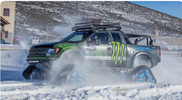Andrew Shadow
Site Supporter
Quebec has a very extensive and vast network of both snowmobile and ATV trails. These trails are inaccessible to on-road emergency vehicles. The trails are to narrow and the terrain to inhospitable for them. These trails often go through areas where no road is anywhere nearby so any emergency becomes more threatening.
Emergencies still happen on these trails. In response in a near-by area there is an emergency response/rescue squad that also has a specialized ambulance/rescue vehicle that is capable of traveling on these trails. It is a specialty vehicle equipped with track drive front and rear. They have prepped it for winter and have it ready to go. Winter can't be far behind.

Emergencies still happen on these trails. In response in a near-by area there is an emergency response/rescue squad that also has a specialized ambulance/rescue vehicle that is capable of traveling on these trails. It is a specialty vehicle equipped with track drive front and rear. They have prepped it for winter and have it ready to go. Winter can't be far behind.



